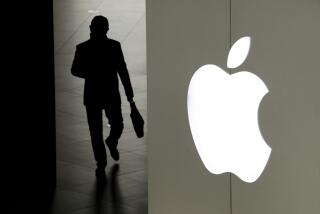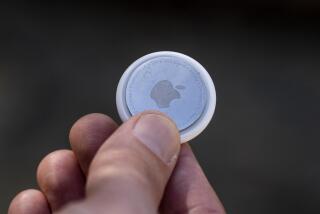Determining the success or failure of the Apple Watch
How will we judge the success or failure of the Apple Watch?
When the Apple Watch goes on sale early next year, there will be a temptation to pass instant judgment on the new gadget. People will want to know right from the start: Is it a hit or a miss?
Apple has fed this mentality in recent years by releasing first-weekend sales figures for the newest iPhones and by constantly trumpeting new sales records, even if at times those comparisons are a bit misleading.
Last year, for instance, those first-weekend figures got a boost because they included sales to China, where the new iPhones for the first time debuted on the same weekend as in the U.S. And the numbers always include phones sold to partners such as AT&T Inc. and Best Buy Co., even if they remain sitting on the shelf after the first weekend. Last year, several analysts said millions of such phones sat around, even as Apple boasted a record 9 million sold.
So, consumers and analysts have been conditioned to focus on first-weekend sales. But will first-weekend sales be a fair way to judge the Apple Watch? No.
No doubt Apple obsessives will be camped out at Apple stores days or weeks before the watch goes on sale, because it’s become a cultural ritual for many people. But it may take years before we know whether the Apple Watch has reached the iconic status achieved by the iPod, iPhone and iPad.
And that’s fine for Apple, which has shown time and again it’s willing to take the long view. But for everyone else, it’s worth setting some context as we take the Apple Watch’s measure.
Let’s start with the watch itself. As amazing as the design is, the $349 starting price (some versions may cost far more) will limit the appeal of what is ultimately an iPhone accessory.
“The Apple Watch positioning is more up-market than we had expected and it only works with iPhone 5 and newer devices, further limiting its initial addressable market,” Toni Sacconaghi, an analyst at Sanford C. Bernstein & Co., wrote in a note to clients. “While the device is aesthetically attractive, and has a very innovative user interface [“digital crown” and differentiated touch], we struggle with the fact that the majority of the Watch’s functionality is dependent on the presence of an iPhone.”
The company also didn’t address battery life directly, a key issue for those who have bought smartwatches. They’re willing to use smartwatches with simple displays and limited functions and give up extras for longer battery life. Such gadgets need to be charged only every couple of days rather than every few hours.
Then there is the larger question all but the most fanatic early adopters will ask about the Apple Watch: What’s the point? Ben Thompson writes about this issue in depth. His main point: Apple hasn’t made a clear case, as it did with past product introductions, what need the watch is filling that can’t be filled with your iPhone, or a bigger iPhone. Those whose central concern is looking trendy and cool represent a niche market, not a mass market.
In fact, there are some features that lend themselves to a wearable computer (all the fitness monitoring, for instance). But the real value will emerge over time as developers get their hands on Apple Watches and create apps and features that leverage the watch and its interaction with the phone and other gadgets. That will take some time.
The biggest issue confronting the Apple Watch is the wearable market’s overall size. Despite tremendous hype in recent years, and numerous high-profile product introductions, the wearable market is just not that big, certainly not as big as many seem to think it is.
Here are two numbers to keep in mind. For the last nine months of fiscal 2014, which ends this month, Apple sold 129.9 million iPhones and 55.7 million iPads.
Now, at the most super-duper optimistic end of the spectrum, Morgan Stanley analyst Katy Huberty thinks Apple could sell 30 million watches in the first year. She made the prediction a few weeks ago, and it’s down from her own previous estimate of 60 million issued earlier this year.
Still, 30 million Apple Watches at $349 would be $10 billion in revenue. Apple had $140.7 billion in revenue in just the first nine months of this fiscal year. That $10 billion would make the watch Apple’s fifth-largest product, behind the iPhone, iPad, Mac and the iTunes and App stores. Most companies would kill for a $10-billion business. For Apple, it’s just a nice start.
In fact, if Apple lumps its watch revenue into the existing accessories category in its financial reports, it will be hard to get a clear read on a product whose revenues might be mingled with sales for the newly acquired Beats products.
The final thing to consider is the replacement cycle for the Apple Watch, a problem iPads and other tablets face now. While Apple and other companies trot out improved versions every year, millions of customers have not felt compelled to upgrade at the same rate they trade in their smartphones. Ask people still using their iPad 2 how they like it. Chances are they’ll tell you it works fine, they’re sure each new version is better, but haven’t yet felt the urge to shell out hundreds of dollars to replace it yet.
Once you have the Apple Watch, how long will it last? Do you buy a new one every year? Every two years? Five years? It depends on what improvements Apple makes. Or how durable it is. But at $349, again, it’s probably something you want to hold on to for as long as you can.
The good news for Apple is that consumers are tuning into wearables. According to a recent Forrester report, 25% of U.S. online adults think they may buy a wearable device in the next year. And they are much more likely to buy something for their wrist than their face (sorry, Google Glass).
So, Apple is dipping its toe into a stream that’s moving in the right direction. The watch seems destined to be among the best-selling wearable computers on the planet.
But it’s not going to be a game changer for Apple’s overall business, in which the iPhone remains the center of the solar system. If people are expecting it to be one of Apple’s top selling products, or to revolutionize lives as some Apple products have done, then it’s bound to fall short.
The challenge facing Apple Chief Executive Tim Cook and Apple over the next few months is this: Building marketing awareness around the Apple Watch to attract customers without letting expectations over sales run wild in the financial community and the media.
If people are expecting a revolution when the watches go on sale next year, Apple could be stuck with a billion-dollar business that’s labeled a failure.
Twitter: @obrien







